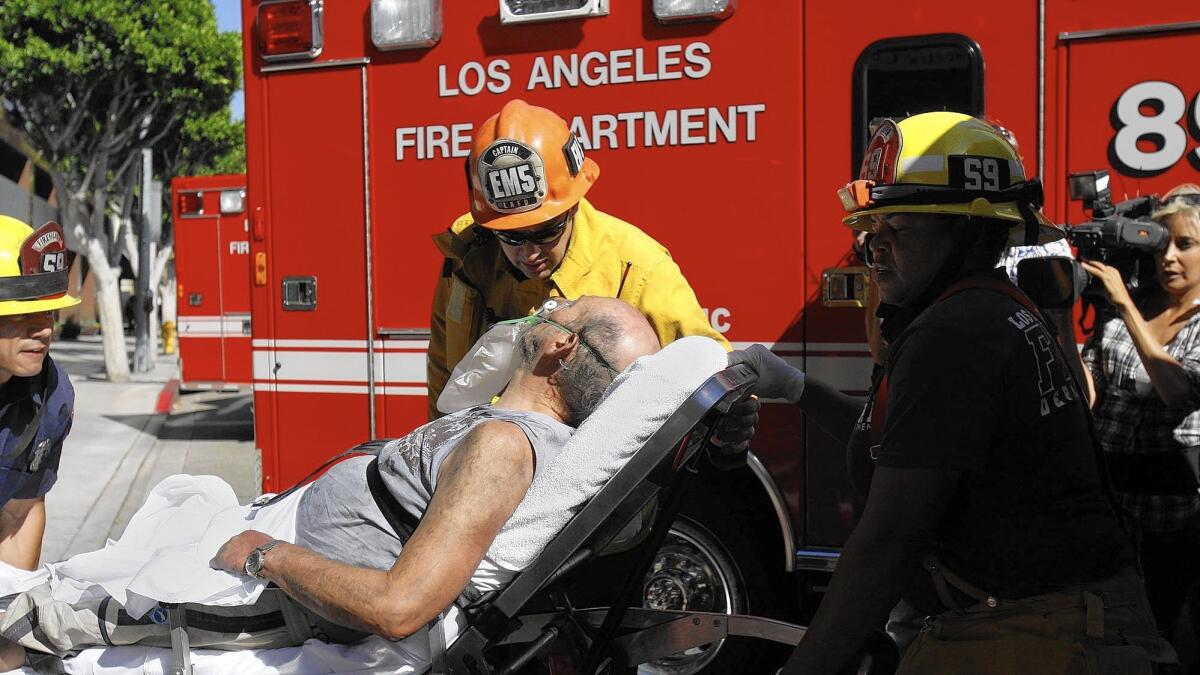Column: Should a man taken to the ER in an ambulance against his will have to pay the bill?

- Share via
As George Varghese tells it, he was walking along a sidewalk in West Los Angeles when he tripped on a crack and fell to the ground, spraining his wrist.
“An ambulance appeared suddenly,” he recalled. “Three men came out, checked my ID, laid me on a cart, pushed me into the van and took me to the emergency room.”
That would seem like a model of paramedic perfection, except for one thing. Varghese, 79, said he didn’t want to go to the ER.
“If I wanted to go to the emergency room, I could have taken a cab costing less than $10,” he said.
Now he’s in the crosshairs of a debt collector for an unpaid $250 ambulance bill — and he doesn’t think he should have to pay it.
This was a new one for me, as it was for Peter Sanders, a spokesman for the L.A. Fire Department. “I’ve never heard of an ambulance just swooping in and taking someone off the street,” he told me.
The complaint I hear most frequently in this regard is the sky-high cost of an ambulance ride, which can easily top $1,000.
A 2012 report by the Government Accountability Office found that the cost of an ambulance ride nationwide can range from $224 to $2,204. In Los Angeles, it typically runs about $1,300, depending on the amount of medical attention required.
Anyone who’s ever experienced an ambulance ride — myself included — probably has a horror story to tell about the crazy fee, even when only basic medical care was provided.
In my case, I had an intense dizzy spell a few years ago and passed out while guest hosting on KPCC-FM (89.3), the Pasadena NPR affiliate. The next thing I knew, I had paramedics checking me for a heart attack and bundling me up for a trip to Huntington Memorial Hospital, just a few blocks away.
Like anyone in such a situation, I wasn’t thinking about money. I was just grateful, albeit barely coherent, to be receiving prompt and efficient treatment. Happily my ticker was fine; it was just a weird virus.
Then the bill came for nearly $1,000 and I remember thinking, “For what?”
“I know what you’re saying,” said Carlos Guerra, general manager of Medi-Star Ambulance, one of a number of private ambulance services working L.A. County. “Some of the rates are outrageous.”
He said most private ambulance companies follow the lead of doctors and hospitals and routinely price their services as high as possible in hopes of receiving a bigger reimbursement from insurance companies.
The ambulance ride might have a full price tag of $1,300, but insurers, including Medicare, typically will pay only a few hundred bucks
“If I didn’t have insurance, that’s when I’d be really scared,” Guerra said.
A federal audit found last year that Medicare paid roughly $30 million for ambulance rides that apparently resulted in no treatment — that is, there’s no record of medical care being provided at the destination.
The Department of Health and Human Services also found that some urban ambulance services were billing Medicare for trips of more than 100 miles. The national average for an urban ambulance ride is 10 miles.
Los Angeles was among the four major metro areas with the highest number of questionable ambulance trips, along with Houston, New York and Philadelphia.
Cathy Chidester, director of Emergency Medical Services for L.A. County, said no ambulance can take patients to hospitals against their will. “That would be kidnapping,” she said.
However, ambulance crews are authorized to make judgment calls if a patient is unconscious or unable to effectively communicate. Chidester said she’s heard from some people who said afterward that, like Varghese, they didn’t approve an ambulance trip.
“But the patient care records told a different story,” she said. “The patient was usually disoriented and not speaking clearly.”
As for an ambulance arriving unusually quickly, Chidester said this is probably an example of “posting.” That’s when an ambulance company stations vehicles at various places around the city or county, awaiting an emergency call.
“Posting gives a shorter response time,” Chidester said. “They’re not looking for people who trip and fall. But if they see something happen, they’ll likely respond.”
She confirmed what Guerra said: Ambulance services routinely charge ridiculous amounts knowing that insurers will pay far less.
If you feel you’ve been overcharged, Chidester advised, “call the company and ask if you can work something out with them.”
And if you find yourself targeted by a debt collector, don’t ignore the collection notice — assert your rights. Tell the collector that you’re disputing the charge and demand written proof of the obligation. By law, debt collectors must provide such information.
The debt collector going after Varghese didn’t return a call for comment. I also couldn’t reach Varghese on Monday to pass along Chidester’s advice.
If I had to guess, I’d say there was some confusion the day he got hurt but at least he was looked after. Better safe than sorry.
I can also say this: Varghese shouldn’t ignore the debt collector. If he does, the damage to his credit score might hurt a lot worse than a sprained wrist.
David Lazarus’ column runs Tuesdays and Fridays. He also can be seen daily on KTLA-TV Channel 5 and followed on Twitter @Davidlaz. Send your tips or feedback to [email protected].
MORE FROM DAVID LAZARUS
Scam victims aren’t dumb; they’re human
Lawmakers are fighting efforts to rein in predatory lending. Why?
Two months after a heart transplant, airline wants him back at work -- or else
More to Read
Inside the business of entertainment
The Wide Shot brings you news, analysis and insights on everything from streaming wars to production — and what it all means for the future.
You may occasionally receive promotional content from the Los Angeles Times.











